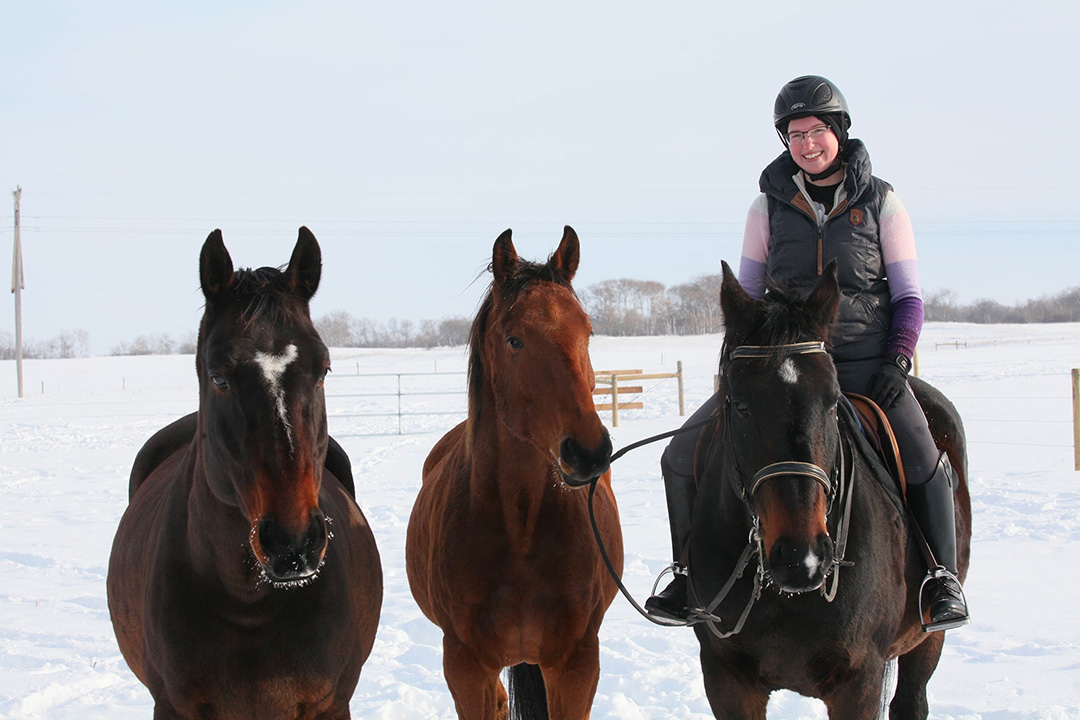
Equine abortions: Chlamydia a culprit?
When veterinarian Dr. Madison Ricard came to the Western College of Veterinary Medicine (WCVM) for her anatomic pathology residency program in 2020, she had no idea that her research would potentially have an impact on the veterinary profession and the horse industry at large.
By Jaidyn BurtonDepending on what she and veterinary pathologist Dr. Bruce Wobeser — her graduate supervisor at the college — uncover in a new research study, their results could lead to substantial changes in how veterinary professionals and members of the horse community manage equine abortions.
The WCVM researchers are investigating the prevalence of Chlamydia psittaci (C. psittaci) in aborted horse placentas. This bacterial pathogen (disease agent) is zoonotic — meaning that it can spread from animals to people. It causes psittacosis, a disease that’s transmitted by birds, which can cause reproductive problems and respiratory disease in horses, people and other mammals.
Over the next year, Ricard and Wobeser plan to test about 100 equine placenta tissue samples that were submitted to Prairie Diagnostic Services (PDS) — the provincial veterinary diagnostic laboratory in Saskatchewan — between 2009 and 2020.
If the WCVM study shows that C. psittaci is causing a percentage of horse abortions in Western Canada, Ricard says veterinarians will need to add more biosecurity measures to their post-mortem examination protocols. Horse owners and breeders will also need to change the way they manage equine abortions on their premises.
“Biosecurity is the act of protecting ourselves from pathogens by wearing gloves, masks, suits, etc., to prevent the bacteria from infecting us or from spreading to other animals. If we have a potentially zoonotic pathogen in these reproductive tissues, we need to be more cautious when handling these tissues and use proper disposal to prevent contamination of the environment,” says Ricard.
When clinicians deal with abortions involving cattle, dogs and sheep, they wear full biosafety suits and gloves, or they use a biosafety cabinet (a big box with a fan to control the bacteria or virus in the air) to examine tissues during post-mortem examinations.
But veterinarians and registered veterinary technologists (RVTs) aren’t taking the same precautions when managing equine abortions. In fact, horses are the only routinely examined species for which clinical team members don’t don personal protective equipment before handling aborted tissues.
The causes of equine abortion are often undetermined, but the presence of Chlamydia in aborted tissue isn’t commonly looked for in samples that are submitted to PDS. The bacterium requires specific testing beyond typical bacterial culture (multiplication), which is used to identify other bacterial pathogens that infect the placenta. For the WCVM research study, the team members are using a different lab technique called polymerase chain reaction (PCR). With PCR testing, they can identify the bacterial pathogen’s DNA and confirm its presence in submitted tissue samples.
Most diagnostic labs don’t routinely test for Chlamydia because veterinarians have considered Chlamydia-induced abortions as rare occurrences in horses. But in 2014, an Australian research team confirmed that veterinary students and technicians who were in contact with the aborted tissues of a mare with Chlamydia contracted the infection.
These findings sparked a further investigation into chlamydial abortions in Australia. After examining archived equine abortion cases from a 25-year period, Australian researchers identified that Chlamydia had previously caused several equine abortions in their country.
Since a large portion of equine abortions have an undetermined cause, Ricard and Wobeser are conducting the same type of study in Western Canada to see if Chlamydia is causing abortions among the region’s horse population.
Even if chlamydial abortions are found to be rare in Western Canada, exposure to Chlamydia is an occupational hazard for veterinary team members. Anyone who handles the reproductive tissues of a horse that aborted due to Chlamydia is at risk of infection unless proper biosecurity measures are taken.
Ricard adds that this study’s results could have an impact on others besides veterinarians and RVTs. Horse breeders and horse owners also need to be educated about Chlamydia, its impact on their horse’s health as well as their own health, and how they can mitigate these health risks.
For example, it’s critical for horse owners and barn staff to wear disposable gloves while handling the mare and the aborted tissues, and afterward, to thoroughly wash their hands with anti-bacterial soap. It’s also important to clean and disinfect all equipment and the mare’s stall or pen before reuse.
If their investigation of past cases confirms that Chlamydia has caused equine abortions in Western Canada, Ricard is interested in looking across Canada and seeing how positive results vary in different regions. The study’s results may not only lead to changes in post-mortem examination protocols, but they could also give insight into regional differences of Chlamydia outbreaks.
The Townsend Equine Health Research Fund (TEHRF) is providing financial support for this study.
Jaidyn Burton of Assiniboia, Sask., is a third-year veterinary student who worked as a summer research student in 2022. Her story is part of a series of articles written by WCVM summer research students.
